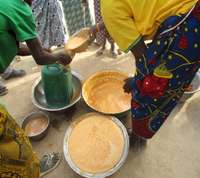The first synthetic pesticides appeared on the market in the 1940s, with very positive results in terms of increasing agricultural yields. Twenty years later, the first accusations of harm to people’s health and the environment were heard in “Silent Spring” (Carson, 1962).
The debate on the risks and benefits of synthetic pest controls has continued since then and a great deal of research has investigated the impact of synthetic pesticides on the environment. In 2022, an estimated 2.7 million metric tonnes of pesticides with registered active ingredients were applied to the world’s crops (FAO, 2022). The proportion of applied pesticide that comes into contact with the target pests or which they ingest is minimal, even less than 0.01% in many instances, due to spray drift during application, abiotic and biotic degradation, and other factors (Duke, 2017). To understand more about how pesticides affect soil, water, air, and animals (including humans), see Pathak et al. (2022).
Broad-spectrum pesticides potentially expose non-target organisms to treatments and undesirable side effects that can impact individuals, communities, and ecosystems. As a pesticide handler, you can be exposed by inhalation or through contact with your eyes, mouth, or skin during mixing/loading of pesticides or during pesticide application. This is true for both synthetic and natural pesticides. Often farmers are not sufficiently educated about how to properly mix and handle pesticides, dispose of pesticide containers, and use personal protection equipment (PPE). To avoid contact with pesticides, read all pesticide labels, use appropriate PPE, and wash clothes and PPE worn while applying pesticides with appropriate caution. If a pesticide label is not available, research the name (common or molecular) of the pesticide to learn more about it before application.1
Synthetic pesticides are one option that many smallholder farmers utilize to ensure crop protection. Factors that impact farmers’ choices to apply synthetic pesticides include social acceptability, marketability of the specific crop if damaged, pest population and density, field size, income, and pest pressure from surrounding farms. Synthetic pesticides are most often relied on when pest populations are at levels too high for cultural or mechanical control options, or farmers are accustomed to using a product. Biopesticides are one alternative to synthetic pesticides that farmers can utilize as part of an integrated pest management plan.
Biopesticides as a natural pest control option
Natural pesticides are made from plant extracts (leaves, fruit, hulls, seeds, etc.) and are accessible to small-scale producers. Certain plants, minerals, or organic materials repel or kill pests by various mechanisms. Producers can use them to prepare solutions known as “biopesticides” or biological pesticides. These preparations act on pests in different ways including repelling, inhibiting reproduction, or eradicating crop pests. Biopesticides are most effective when applied regularly as a preventive measure.
This article presents two biopesticides popularized by ECHO West Africa. These biopesticides are based on farmers’ experience, cultural knowledge, and know-how.
Chili, garlic, onion, and neem almond powder biopesticide
This is a broad-spectrum biopesticide based on chili (Capsicum annuum), garlic (Allium sativum), onion (Allium cepa), and neem (Azadirachta indica) powder, each containing active ingredients to combat pests.
Ingredients:
- 1 kg of garlic, peeled
- 1 kg of neem almond powder2
- 1 kg of hot pepper
- 1 kg of onion, peeled
- 1 piece of soap3
- 7 L of water
Equipment required:
- mortar
- sieve or scarf
- bucket (with lid if possible)
- clean, empty can(s) to hold the product
Preparation:

Figure 1. Chili, garlic, and onion being ground in a mortar and mixed. Source: ECHO West Africa Staff
- Be careful when preparing the product. Protect your hands and eyes from the chili pepper by wearing gloves and protective eyewear.
- Pound the ingredients (chili, garlic, onion, neem seed without shells, and piece of soap; Figure 1)
- Mix all these ingredients in a bucket
- Add 5 L of water, stir, and leave to stand for 24 hours
- Filter the content through a fine sieve or scarf (Figure 2)
- Add 2 L of water to the residue and filter again
- Mix together and place in a can for storage (Figure 3)

Figure 2. Filtering the mixture obtained after 24 hours of fermentation. Source: ECHO West Africa Staff

Figure 3. Storage of biopesticide in 20 L cans. Source: ECHO West Africa Staff
Product use:
Dilute the product at a rate of 1 L of product for 9 L of water or take 1.5 L of product for 13.5 L of water to put in a 16-L sprayer. Treatments are best carried out in the evening. It can be used as a curative or preventive treatment once a week or every two weeks. A 6-L volume of undiluted product is enough to cover one hectare.
Product storage:
Close the container lid tightly. The product can be stored for up to three months. Each time the can is opened, the product loses some effectiveness. It’s best to pack the product in 0.5 L bottles and keep them in a dry, shady place.
Target Pests:
The product is effective against insects such as whiteflies (Aleyrodidae), caterpillars (Lepidoptera), locusts (Schistocerca gregaria), termites (Isoptera), ants (Formicidae), and aphids (Aphidoidea). This biopesticide can also be used to treat chicken fleas (Ceratophyllus gallinae) in local chicken flocks.
Ash broth biopesticide
This is a biopesticide made by following a cooking process using wood ash, chili, and local soap.
Ingredients:
- 3 kg of clean wood ash (well sieved)
- 2 kg of local soap, grated/powdered
- 0.5 kg of dry or fresh hot pepper
- 25 L of water
Equipment required:
- bucket
- mortar
- large pot
- sieve
- tinted bottles or cans 4
Preparation:

Figure 4. Adding soap to the preparation of ash broth. Source: ECHO West Africa Staff
- Boil water in the pot
- Add the soap to the boiling water, allowing it to melt without stirring (Figure 4)
- Wait two minutes and add some ash while stirring
- Add the hot pepper (Figure 5)
- Let it boil vigorously for at least 10 minutes, stirring constantly
- Remove from heat and let cool

Figure 5. Adding chili pepper to the preparation of ash broth. Source: ECHO West Africa Staff
Using the product:
Dilute the product at a rate of 1 L of product for 15 L of water in the 16-L sprayer. Treatments are best carried out in the evening. It can be used as a curative or preventive treatment once a week or every two weeks.
Product storage:
The preparation is filtered and packaged in tinted or colored bottles or cans and stored in a dry, shady place for up to six months.
Target pests:
This preparation can be used to control aphids, whitefly, caterpillars, and mealy bugs (Pseudococcidae). This biopesticide can also be used to treat lice (Menoponidae) in local chicken flocks.
Conclusion
Biopesticides are prepared from local organic or mineral materials and help limit the invasion and spread of crop pests and diseases. They do very little harm to the environment or farmers and consumers’ health. They are easy to prepare and use and require minimal preparation costs.
References
Carson, R. 1962. Silent Spring. Boston :Houghton Mifflin, 2002.
Duke, S.O. 2017. Pesticide Dose – A parameter with many implications: Effects on the environment and target and non-target organisms. American Chemical Society.
FAO. 2022. Pesticides use, pesticides trade and pesticides indicators – Global, regional and country trends, 1990–2020. FAOSTAT Analytical Briefs, no. 46. Rome. https://doi.org/10.4060/cc0918en
Pathak V.M., V.K. Verma, B.S. Rawat, B. Kaur, N. Babu, A. Sharma, S. Dewali, M. Yadav, R. Kumari, S. Singh, A. Mohapatra, V. Pandey, N. Rana, and J.M. Cunill. 2022. Current status of pesticide effects on environment, human health and it’s eco-friendly management as bioremediation: A comprehensive review. Frontiers in Microbiology 13:962619. doi:10.3389/fmicb.2022.962619.